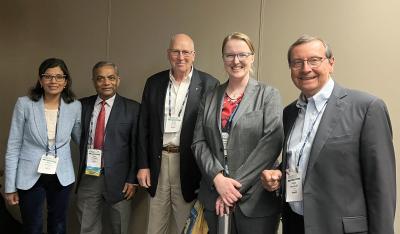
Presenters at the climate and eye health session. From left: Nisha Acharya, Gyan Prakash, Hugh Taylor, Cassandra Thiel, and Serge Resnikoff.
To better understand eye health care needs of the future, the National Eye Institute (NEI) convened a panel of experts April 26, 2023, at the annual meeting of the Association for Research in Vision and Ophthalmology (ARVO).
The panel discussed the potential effects of a changing climate on eye health and vision. Eye health care depends on proper infrastructure, resources, and personnel, understanding population behaviors, disease vector patterns, environmental events, and more. The session described estimates for future eye disease burden and population changes, gaps in our healthcare resiliency and ability to provide care in diverse regions, and the need for more research into environmental drivers of eye disease.
Speakers at the event included Hugh Taylor, M.D., University of Melbourne; Nisha Acharya, M.D., University of California, San Francisco; Cassandra Thiel, Ph.D., New York University; and Serge Resnikoff, M.D., Ph.D., University of New South Wales. The session was moderated by Gyan Prakash, Ph.D., NEI Associate Director for International Research.
Aging populations around the globe will lead to more blinding eye disease, including cataract, glaucoma, and age-related macular degeneration (AMD), noted Taylor. Rising temperatures will drive populations away from the equator, according to Resnikoff, increasing the eye healthcare burden in other areas. Acharya noted that we have a poor understanding of how particulate air pollutants, like those emitted by wildfires, drive chronic eye inflammation, and contribute to diseases like uveitis, cataract, and AMD. In addition, she said, most programs exploring the impacts of climate change on health don’t cover eye health.
Speakers offered potential solutions for future challenges. For example, more efficient eye healthcare would better accommodate both population aging and migration. Thiel described ways to limit the eye healthcare footprint and increase the resiliency of clinics to ensure continuity of care during environmental disasters.
“I hope this session will help up develop new research programs to support eye and vision health for decades to come,” said Prakash.